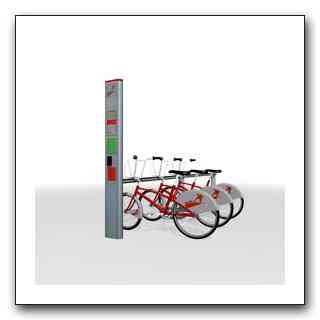Spending to Protect Assets
 There’s a story in the New York Times about a bike rental program in Washington DC. It’s targeted at residents, not tourists, and has a subscription-based model.
There’s a story in the New York Times about a bike rental program in Washington DC. It’s targeted at residents, not tourists, and has a subscription-based model.
Improved technology allows programs to better protect bicycles. In Washington, SmartBike subscribers who keep bicycles longer than the three-hour maximum will receive demerits and could eventually lose renting privileges. Bicycles gone for more than 48 hours will be deemed lost, with the last user charged a $200 replacement fee.
That technology comes with a price, which is one reason cities and advertisers started joining forces to offer bike-sharing. The European programs would cost cities about $4,500 per bike if sponsors did not step in, Mr. DeMaio said. “Bicycle-Sharing Program to Be First of Kind in U.S.”
$4,500 is 22.5 bikes. Put another way, they could buy 2,500 bikes, rather than the 120 they’re buying. That would require a lot more space if you bought them all at once, but you might just buy them as bikes are stolen. Looking at it another way, if you took the $500,000 being spent on technology, and invested it at 5%, you would make $25,000 per year, enough to completely replace the fleet annually.
This is (obviously) an incomplete analysis. But the cost of protection jumped out at me. Maybe it’s typical for how people in Washington think about asset protection.
It’s not clear to me from the article if the $4,500 figure is just for the security features, or whether it includes the bikes, racks, administrative overhead, etc. If it’s all-inclusive it might be a lot more reasonable. For that matter, even if the security features exceed the cost of the bike they might be worth it if they keep the bikes available — no one is going to subscribe if they consistently find empty racks due to all the bikes having been stolen, and a project with a high theft rate would no doubt quickly be abandoned as a political boondoggle.
It is standard for a service price to differ remarkably from a commodity price. Moving more of the user’s components into the service can more correctly identify more of the trade.
Consider a half-liter of beer (or your favourite measure). In bulk at the supermarket it might cost 50c (total guess, not close to any USD supermarkets today). But at the pub, it is more likely to go for around $2-3. The service component easily dominates, and indeed they could practically give away the liquid. Indeed, this differential in service price is popularly arbitraged in Australia, where it is called BYO.
Here closer to me the city bike programme is quite popular. The dominant model does seem to be subscription to a well-identified local person, and tourists generally have to ask a local to enable them a bike somehow. The rule is that you are charged only if you have it for longer than an hour. There are bike points all over the city so it is a reasonable commuting proposition. Having sufficient locations to secure the bikes, rented from the city, probably adds a hefty premium.
It’s possible, though, that the technology is closely related to theft rates. If there were no accountability, it seems, to me, entirely plausible that the entire fleet and then some would walk off in the course of a year.
Of course, one might imagine lower-tech solutions, like engraving the bikes with an identifiable logo to make fencing more difficult.
There’s also the cost of diminished service to add to the cost of theft. Not only is the bike itself missing, but the lower service quality, in terms of fewer bikes being available, might hurt subscription as a whole.
It’s a reach to justify the seemingly exorbitant price of the protection technology, even so, but not completely impossible to imagine, I think.